Back to Don's Maps
 Back to Archaeological Sites
Back to Archaeological Sites
 Back to the review of hominins
Back to the review of hominins
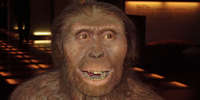 Readers may be also interested in this page on 'Lucy'
Readers may be also interested in this page on 'Lucy'
Lucy's baby
Click on the photos to see an enlarged version
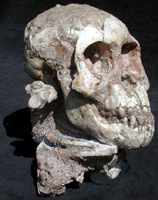
Photo: by Zeresenay Alemseged, ©2006 Authority for Research and Conservation of Cultural Heritage (ARCCH) at the website
http://news.nationalgeographic.com/news/2006/09/060920-baby-photos.html
20 September 2006
Jeff Hecht
The stunningly complete skeleton of a three-year-old girl who lived 3.3 million years ago has been uncovered in Ethiopia. The child belongs to the species Australopithecus afarensis like the famous "Lucy", who was discovered in 1974. The young age of the so-called Dikika child, now known as Selam, promises new insights into the growth of early humans.
The new find is the most complete and important skeleton of an immature Pliocene hominin ever found, says Tim White of the University of California, Berkeley, who worked on the Lucy discovery. "The gist of the current paper is, 'Eureka, we have it'," he says.
A team led by Zeresenay Alemseged of the Max Planck Institute for Evolutionary Anthropology in Leipzig, Germany, spotted the first bones south of the Awash river on 10 December 2000. The team spent four field seasons scouring the area for every scrap of the skeleton.
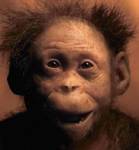
Photo: National Geographic, reported in the Sydney Morning Herald 21st September 2006
Lucy was also found in the Awash region, which is famed for its early human fossils. Many anthropologists think A. afarensis was ancestral to the genus Homo, though its exact position in the human family tree remains a matter for debate.
Alemseged's team believes that a flood rolled the child's body into a ball and buried it in sand soon after her death, before the bones could be weathered or pulled apart by scavengers.
Analysis of the skeleton has barely begun because the upper parts, including the skull, shoulder blades, collarbones, ribs and backbone, are still largely encased in a block of hard sandstone. However, a CT scan of the skull revealed tooth development matching that of a three-year-old, the team reports in Nature (vol 443, p 296).
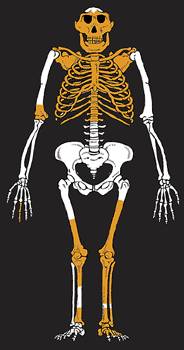
The skeleton, DIK-1-1, is the most complete ever found of an early hominin child.
Photo: http://www.sciam.com/includes/pop_00076C1D-62D1-1511-A2D183414B7F0000_dikika.cfm
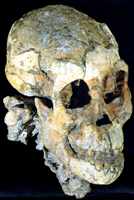
Photo: Zeresenay Alemseged, ©2006 Authority for Research and Conservation of Cultural Heritage (ARCCH), reported in the Sydney Morning Herald 21st September 2006
"At least 50 per cent of the skeleton is there, but more importantly we have the face and brain endocast, and the whole skull, telling us clearly how the [child] looked," says Alemseged. He estimates the brain size was 330 cubic centimetres, between 63 and 88 per cent of the size of an adult of the species. This hints at brain growth slower than in chimpanzees, whose brains have reached 90 per cent of adult volume by age three. A. afarensis may therefore have begun evolving the slower brain development characteristic of modern humans.
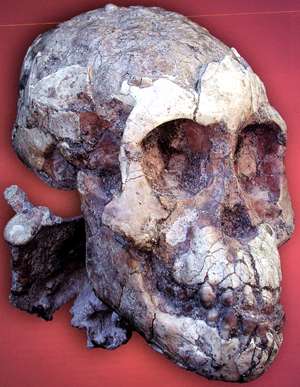
Photo: Scientific American Vol 295 Number 6 December 2006
The exposed leg bones show the child walked bipedally like Lucy. In contrast, the shoulder blade "in some ways resembles young gorillas", says collaborator Bill Kimbel of Arizona State University. That supports the inference from Lucy's long arms that she was a better climber than modern humans. During the girl's lifetime the environment was a mosaic of forest and savannah, so the species may have gathered food and slept in trees, but walked from place to place.

Long, curved finger bones suggest that A. afarensis may have been partly arboreal, that is, it may have lived in trees.
Text and photo: http://www.sciam.com/includes/pop_00076C1D-62D1-1511-A2D183414B7F0000_dikika.cfm
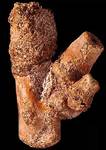
Characteristics of the foot bones, including the humanlike wideness of the heelbone, denote a hominin that was a capable biped.
Text and photo: http://www.sciam.com/includes/pop_00076C1D-62D1-1511-A2D183414B7F0000_dikika.cfm

The fossil also preserves the delicate hyoid bone which anchors throat muscles, used in speech. This is only the second fossil hominin hyoid bone ever found - the first was from a much younger Neandertal skeleton. Its shape suggests that A. afarensis had a chimplike voicebox.
Text and photo: http://www.sciam.com/includes/pop_00076C1D-62D1-1511-A2D183414B7F0000_dikika.cfm
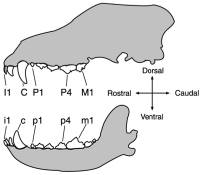
The diagram at left is of a dog.
These are the standard abbreviations for mammalian teeth when described in vertebrate paleontology:
Anatomical Abbreviations: C, canine, maxilla; c, canine,
mandible; d, dentar y; D, deciduous; ect, ectopter ygoid; I, in-
cisor, premaxilla; i, incisor, mandible; M, molar, maxilla; m,
molar, mandible; mx, maxilla; P, premolar, premaxilla or max-
illa; p, premolar, mandible; pal, palatine; pm, premaxilla; ps,
parasphenoid; pt, pter ygoid; sph, sphenoid; spl, splenial; v, vo-
mer.
Text and photo:
Department of Earth and Environmental Science Departmental Papers (EES) University of Pennsylvania Year 2003
A proposal for a standard terminology of
anatomical notation and orientation in
fossil vertebrate dentitions
Joshua B. Smith Peter Dodson
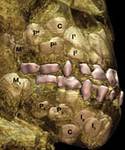
CT images reveal that in addition to having the milk teeth, the Dikika baby has unerupted adult teeth still in the jaw.
M = Molar
C = Canine or Cuspids
I = Incisor
P = Premolars
Text and photo: http://www.sciam.com/includes/pop_00076C1D-62D1-1511-A2D183414B7F0000_dikika.cfm
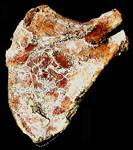
The earliest shoulder blade in the human fossil record, this bone is very gorilla-like in shape. Its upward-facing shoulder socket (in contrast to our more laterally (sideways) oriented one) lends tentative support to the idea that in addition to walking bipedally on the ground, A. afarensis spent time in the trees.
Text and photo: http://www.sciam.com/includes/pop_00076C1D-62D1-1511-A2D183414B7F0000_dikika.cfm

To the top left (a) is the scapula of the Dikika fossil, (b) in the top right is a gorilla's scapula, and to the bottom left, (c) is the human scapula and (d) on the bottom right is a chimpanzee scapula.
The shape of the Dikika fossil scapula is midway between that of a gorilla's scapula and that of a human.
Photo: http://www.nature.com/
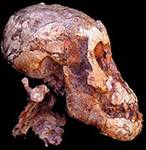
Features of the face including the small, narrow nasal bones, identify this creature as A. Afarensis, as opposed to the closely related A. Africanus. Although much of the brain case is missing, the fossil preserves a natural sandstone endocast, or impression of the interior of the skull. The apparent brain size hints that A. afarensis may have had delayed brain growth relative to chimps, which is characteristic of modern humans.
Text and photo: http://www.sciam.com/includes/pop_00076C1D-62D1-1511-A2D183414B7F0000_dikika.cfm
![]()
Features of the femur and tibia indicate that this three-year-old was fully bipedal.
Text and photo: http://www.sciam.com/includes/pop_00076C1D-62D1-1511-A2D183414B7F0000_dikika.cfm
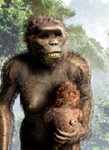
Photo: Artist's conception of a mother and child Australopithecus afarensis. Adult females of the species were some 3½ feet tall, judging from the "Lucy" specimen. http://www.world-science.net/othernews/060920_baby-afarensis.htm
Another key discovery is a hyoid bone, which is found in the throat and in humans is involved in speech. Until now, only one fossil hyoid has ever been found, and it was from a Neanderthal. The Dikika hyoid resembles an ape's, suggesting speech had not begun to evolve in A. afarensis.
Alemseged believes much information can be gained once the skeleton is freed from its stone casing. "A clear picture will emerge of how baby human ancestors were built, and how they grew up," he says.
Text: http://www.newscientist.com/channel/being-human/mg19125703.300
This section is adapted from the paper by Jonathan G. Wynn, Zeresenay Alemseged and Diana C. Roman, available as the pdf file:
WynnDikika.pdf
at the website:
http://www.gl.rhul.ac.uk/ear_conference/ear_abstractspdf/

The Afar region of Ethiopia (which includes the Dikika Area) has fossils representing the three major stages of human evolution, i.e.
i) the appearance of the first hominins (apes and humans are now collectively called hominids, while humans and their ancestors are called hominins) after the split with the great apes, around 6 Ma (6 million years ago).
ii) the emergence of the genus homo, around 2.5 Ma.
iii) the advent of our own species, Homo sapiens, at around 200 000 years ago.
The fossil animals, the type of sediments, the fossil pollen records and the chemical makeup of the sediments show that the area had very different, though changing, environments compared with those of today over the last 6 million years.
Photo: Google Earth
In general, the environments changed from woodlands and forests to more open environments such as grasslands.
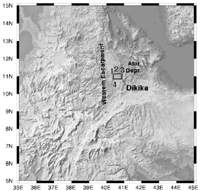
Figure 1. Location map of the Dikika Research Project area showing relationship to surrounding
paleoanthropological research areas in Ethiopia, and to major tectonic features. 1 = Gona, 2 =
Hadar, 3 = Middle Ledi, 4 = Middle Awash
The Dikika area lies on the western margin of the Afar depression, which sits at the intersection of the
Ethiopian Rift with the Gulf of Aden Rift and Red Sea Rift (photo at left), spanning the area between the active axis of faulting (the Tendaho
and Issa Grabens) and the lower slopes of the Ethiopian Rift's Western Escarpment.
Photo: http://www.gl.rhul.ac.uk/ear_conference/ear_abstractspdf/
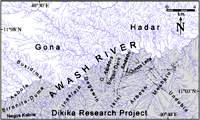
The area is partially uplifted on a group of faults which follow the trend of the Ethiopian Rift (~N30°E), and which
form the central graben at Andedo (photo at left). Note that the map gives the impression of a well watered area. Nothing could be further from the truth.
A number of faults run across the area, which follow the approximate orientation of the Red Sea Rift, and Gulf of Aden Rift, neither of which appear to be deposited at the same time.
Photo: http://www.gl.rhul.ac.uk/ear_conference/ear_abstractspdf/
In general, these faults uplift the southern portion of the area such that older sediments and igneous basement rocks are generally exposed to the south and east. Volcanic rocks in this portion of the rift system generally become younger to the east, and the active volcanism today is along the line of the Issa and Tendaho Graben, east of Dikika.
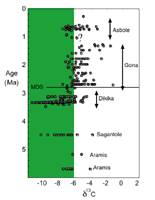
Many of the basalts bounding the basin have been dated to 3-4 Ma, (3-4 million years ago) while rocks from the rhyolitic complex
at Ida Ale, northeast of Dikika have been dated to 3.6-3.2 Ma, all of which is
consistent with the local area being near the active spreading center during the period from ~4 to
~3 Ma. Following ~3 Ma, there is a major change in the tectonic setting. At Dikika, the disconformity cuts across
strata and across the northeast trending faults, cutting deeper into the section progressing
eastward, and separates the strata into units with markedly different sedimentary character.
Photo (ages of Dikika and other sediments in the region):
http://www.gl.rhul.ac.uk/ear_conference/ear_abstractspdf/
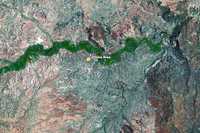
Close up of the Dikika Area.
Photo: Google Earth
Although there are intervals of lake sediments, the lakes were mostly not stable over long periods of time, but instead were filled after rain and then evaporated, though there were some long lived lakes. There were also wind-borne deposits, as well as some deposits of conglomerates and from rivers, in the form of cross-bedded sandstones, with or without fine gravel bases.
The sea floor encroaches on the Afar Depression
This excellent article comes from Harowo.com, which, according to the website, "is a daily blog dedicated to be the authoritative internet information source for the people of the Horn of Africa particularly Somaliland, a grassroots democracy in a region otherwise characterized by misrule, cyclical famines, environmental degradation and chronic underdevelopment. Through the selection of relevant news articles, cool analysis, witty commentary and passionate argument, Harowo.com strives to provide its readers a forum where they can find objective information and up-to-date news about the Horn of Africa and beyond."Harowo.com is maintained by Ahmed Sh. Farah, a longtime resident of Washington DC. USA.
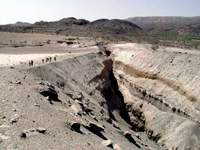
Normally new rivers, seas and mountains are born in slow motion. The Afar Triangle near the Horn of Africa is another story. A new ocean is forming there with staggering speed - at least by geological standards. Africa will eventually lose its horn.
Geologist Dereje Ayalew and his colleagues from Addis Ababa University were amazed - and frightened. They had only just stepped out of their helicopter onto the desert plains of central Ethiopia when the ground began to shake under their feet. The pilot shouted for the scientists to get back to the helicopter. And then it happened: the Earth split open. Crevices began racing toward the researchers like a zipper opening up. After a few seconds, the ground stopped moving, and after they had recovered from their shock, Ayalew and his colleagues realized they had just witnessed history. For the first time ever, human beings were able to witness the first stages in the birth of an ocean.
Photo and text: http://harowo.com/2006/03/15/africas-new-ocean/
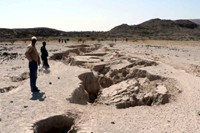
Normally changes to our geological environment take place almost imperceptibly. A life time is too short to see rivers changing course, mountains rising skywards or valleys opening up. In north-eastern Africa's Afar Triangle, though, recent months have seen hundreds of crevices splitting the desert floor and the ground has slumped by as much as 100 meters (328 feet). At the same time, scientists have observed magma rising from deep below as it begins to form what will eventually become a basalt ocean floor. Geologically speaking, it won't be long until the Red Sea floods the region. The ocean that will then be born will split Africa apart.
The Afar Triangle, which cuts across Ethiopia, Eritrea and Djibouti, is the largest construction site on the planet. Three tectonic plates meet there with the African and Arabian plates drifting apart along two separate fault lines by one centimeter a year. A team of scientists working with Christophe Vigny of the Paris Laboratory of Geology reported on the phenomenon in a 2006 issue of the Journal of Geophysical Research. While the two plates move apart, the ground sinks to make room for the Red Sea and the Gulf of Aden.
A third crevice cuts south, splitting not far from Lake Victoria. One branch of the rift runs to the east, the other to the west of the lake. The two branches of this third crevice are moving apart by about one millimeter a year.
The dramatic event that Ayalew and his colleagues witnessed in the Afar Desert on Sept. 26, 2005 was the first visual proof of this process - and it was followed by a week-long series of earthquakes. During the months that followed, hundreds of further crevices opened up in the ground, spreading across an area of 345 square miles. "The earth has not stopped moving since," geophysicist Tim Wright of the University of Oxford says. The ground is still splitting open and sinking, he says; small earthquakes are constantly shaking the region.
Scientists have made repeated trips to the area since the drama of last September. Locals have reported a number of new cracks opening in the ground, says geologist Cynthia Ebinger from the University of London, and during each visit, new crevices are discovered. Fumes as hot as 400 degrees Celsius (752 degrees Fahrenheit) shoot up from some of them; the sound of bubbling magma and the smell of sulphur rise from others. The larger crevices are dozens of meters deep and several hundred meters long. Traces of recent volcanic eruptions are also visible.
In a number of places, cracks have opened up beneath the thin layer of volcanic ash that covers the region. As there is no ash in the fissures, it's clear that they opened up after the volcanic eruptions, most of which took place at the end of September or in October, 2005. A number of locals who fled the eruptions have reported that a black cloud of ash - spewed out of the Dabbahu volcano - darkened the sky for three days.
Basalt magma has risen into some of the crevices. For the moment, Ayalew explains, the lava seems not to be rising further. A number of recent eruptions, though, have left layers of new basalt lava on the Earth's surface. And it's the exact same kind of lava that spews out of volcanic ridges deep under the ocean - a process which slowly pushes older lava sediments away on either side. The process has only just begun in the Afar Triangle - and scientists for the first time can witness the birth of a new ocean floor.
The source of the African magma looks to be a gigantic stream of molten rock rising from beneath the Earth's crust and slicing through the African continental plate like a blow torch. It's a process that began thirty million years ago when lava broke through the continent for the first time, separating the Arabian Peninsula from Africa and creating the Red Sea.
Now, it's the Afar Triangle's turn and it's sinking rapidly. Large areas are already more than 100 meters (328 feet) below sea level. For now, the highlands surrounding the Denakil Depression prevent the Red Sea from flooding these areas, but erosion and tectonic plate movement are continually reducing the height of this natural barrier. The Denakil Depression, which lies to the east of Afar, is already prey to regular floods - each flood leaving behind a crust of salt.
Photo and text: http://harowo.com/2006/03/15/africas-new-ocean/
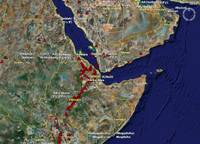
The chain of volcanoes that runs along the roughly 6 000 kilometer (3 730 mile) long East African Rift System offers further testimony to the breaking apart of the continent. In some areas around the outer edges of the Rift System, the Earth's crust has already cracked open, making room for the magma below. From the Red Sea to Mozambique in the south, dozens of volcanoes have formed, the best known being Mt. Kilimanjaro and Mt. Nyiragongo.
These fiery mountains too will one day sink into the sea. Geophysicists have calculated that in 10 million years the East African Rift System will be as large as the Red Sea. When that happens, Africa will lose its horn.
Text: http://harowo.com/2006/03/15/africas-new-ocean/http://harowo.com/2006/03/15/africas-new-ocean/
Photo: Google Earth
Pint-Size 'Lucy'
Found in Ethiopia, the fossilized skeleton of a young girl belongs to a pre-human species that is considered a symbol of evolution.
Text below from: http://www.latimes.com/news/nationworld/nation/la-sci-babybones21sep21,1,7079396.story?coll=la-headlines-nation&ctrack=1&cset=true
By Robert Lee Hotz, Times Staff Writer
September 21, 2006
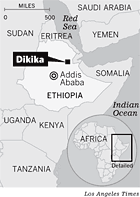
Photo: Los Angeles Times.
No one knows how her body found its way into the stream or how long her parents may have searched the shallows for the missing 3-year-old.
The child's fossilized skeleton - a tiny skull, a jaw with baby teeth still intact, a clutch of finger bones, the curled commas of ribs - are remains of a domestic calamity 3.3 million years ago when the human family was in its infancy, so long ago that the river in which she may have drowned has turned to stone.
Discovered in Ethiopia, her primitive skeleton is the oldest complete set of child remains on record, at least 3 million years older than any other comparable fossil of childhood, scientists announced Wednesday in the journal Nature.
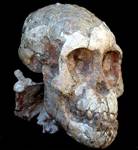
Photo: http://www.heise.de/tp/r4/artikel/23/23595/1.html
The tiny female was the child of an ancestral pre-human species called Australopithecus afarensis, the same species as the iconic fossil specimen Lucy - long celebrated in the popular imagination as a symbol of human evolution. Their kind thrived in East Africa 3 million to 4 million years ago. Modern humankind, by comparison, arose 200 000 years ago.
The subject of intense scientific scrutiny, the child's bones are yielding insights into the origins of upright walking, brain development, the beginnings of speech and the unique pace of childhood development that sets humankind apart from all other primates, the researchers said.
Displaying the shoulders of a young gorilla and legs jointed more like a human girl, her bones merge the anatomy of humanity's earliest ancestors with more contemporary human characteristics, several experts said. She may have deftly swung from branches but also easily walked erect, even at age 3, the fossils suggest.
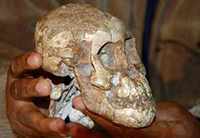
Photo: http://www.khaleejtimes.com
With a brutish jutting jaw, flat nose, and a weak, sloping forehead, she had a face only a mother - or an anthropologist - could love.
"For us, the excitement is that this is a young child in the middle of a period when lots and lots of growth is happening, when the brain is developing, when the teeth are erupting, when the limb bones are growing," said paleoanatomist Fred Spoor at University College London who studied the find.
"Understanding growth and development is the key to evolution. That is the wider importance of the skeleton. You can study those processes at the beginning of human evolution - to see how you grow a new species," Spoor said.

Photo: http://www.heise.de/tp/r4/artikel/23/23595/1.html
Indeed, her bones contain "the biography of a species," said paleoanthropologist Zeresenay Alemseged at the Max Planck Institute for Evolutionary Anthropology in Leipzig, Germany, who led the international research team that made the find.
The child's bones were discovered in December 2000 in the remote Dikika desert region of northeastern Ethiopia.
Sweating in the hour of long shadows before sunset, Zeresenay and Tilahun Gebreselassie, a colleague from the Ethiopian Ministry of Culture, combed the steep rocks along an arid hillside. Two soldiers stood watch as they searched the ground, to guard against a possible raid by neighboring tribes.
Then, Tilahun spotted the discolored edge of an ancient cheekbone in the sand, Zeresenay recalled.
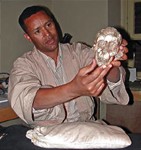
Photo:
http://deseretnews.com/dn/view/0,1249,650192409,00.html
Dr. Zeresenay Alemseged shows the skull of a 3-year-old Australopithecus afarensis at the National Museum of Ethiopia in Addis Ababa, Ethiopia.
Her face was partially exposed, but her skull, shoulder blades, collarbones, ribs and backbone all were cemented in a hard ball of sandstone no bigger than a cantaloupe. Most of her ribs were positioned, as in life, along the curving spinal column.
Over the next three field seasons, researchers painstakingly picked through the hillside rocks to recover as many bone fragments as possible. Their work was supported by the French Center for Ethiopian Studies, the Institute of Human Origins at Arizona State University, the Leakey Foundation, the National Geographic Society and the Max Planck Society.
So far, they have found her entire skull, containing a natural sandstone impression of her growing brain, as well as most of her torso and limbs. One knee joint was covered by a kneecap no bigger than a dried pea, the researchers said.
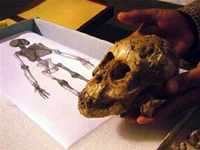
Photo:
http://www.lenta.ru/news/2006/09/21/lucy/
'It is a very special discovery', said anthropologist Bernard Wood, an expert on human origins at George Washington University who was not involved in the research. 'The degree of completeness is without parallel in a fossil this early'.
Her brain was small, measuring not much larger than that of a chimpanzee of the same age. Her finger bones were curved and almost as long as a chimp's, suggesting to researchers that she may have used them to cling to her mother or, more tellingly, to branches.
In the same way, the shape of the toddler's inner ear, crucial to balance and equilibrium when moving, appeared more ape-like than human, the researchers reported.
All told, it took Zeresenay five years to partially clean and analyze the tiny skeleton, picking away the sandstone encrusting the bones a grain at a time with dental tools. Several more years of work will be needed to free all the bones from their sandstone tomb.
Hominin timeline.
Note that Homo floresiensis has not been placed on this timeline. van den Bergh et al. (2016) indicate that it may be a form of Homo erectus.
Photo: © National Geographic, Jason Treat, NGM staff
Source: Lee Berger, University of the Witwatersrand (WITS), John Hawks, University of Wisconsin-Madison
Proximate source: http://news.nationalgeographic.com/2017/05/homo-naledi-human-evolution-science/
References
- Dean, M., Smith, B., 2009: The First Humans – Origin and Early Evolution of the Genus Homo Vertebrate Paleobiology and Paleoanthropology, Springer Netherlands
- Kimbel, W., Johanson, D., and Rak, Y., 1994: The first skull and other new discoveries of Australopithecus afarensis at Hadar, EthiopiaNature, 368: 449-451.
- Kimbel, W., Rak, Y., and Johanson, D. , 2004: The skull of Australopithecus afarensis, New York: Oxford University Press.
- van den Bergh G. et al., 2016: Homo floresiensis-like fossils from the early Middle Pleistocene of Flores, Nature, 534 (7606): 245–248. doi:10.1038/nature17999. PMID 27279221.
